Drilling overlapping holes
 My mom asked me to look at a door at the cottage that had become impossible to close.
My mom asked me to look at a door at the cottage that had become impossible to close.
What had happened is that the foundations had settled and shifted a little bit, and so the door opening had become slightly parallelogram shaped while the door was still square. But jacking the foundations wasn't an easy option in this case. The shifting wasn't that great, and I realized that if I moved the door down by about half a centimeter, it would be ok on both the top and bottom. And the way to shift the door down was to move the hinges.
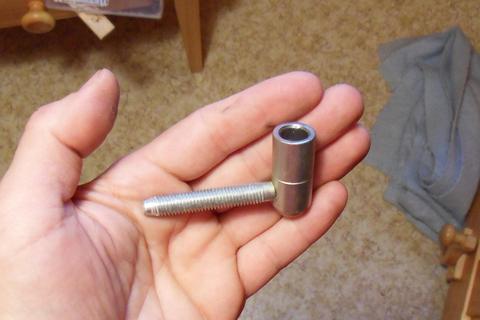 When we built the cottage my dad used these clever
German hinges that mount by long tangs that screw straight into the door and
the door frame. What's cool about these hinges is that the fit of the door can be adjusted
after they are mounted by screwing either tang in or out from the door or the frame.
Unfortunately, there is no means of adjusting up/down.
When we built the cottage my dad used these clever
German hinges that mount by long tangs that screw straight into the door and
the door frame. What's cool about these hinges is that the fit of the door can be adjusted
after they are mounted by screwing either tang in or out from the door or the frame.
Unfortunately, there is no means of adjusting up/down.
The easiest way to make a half a centimeter vertical adjustment would have been to move the whole hinge by about two centimeters, drilling a new set of holes so that neither hole would overlap the existing holes.
Unfortunately, my dad had attached the trim around the door frame after screwing in the hinges, and the only way to get enough clearance to unscrew the hinge was to remove the trim. But the trim was glued in place and the only way to get it off would be to destroy it. Not something I wanted to do, so the door frame half of the hinges had to stay in place.
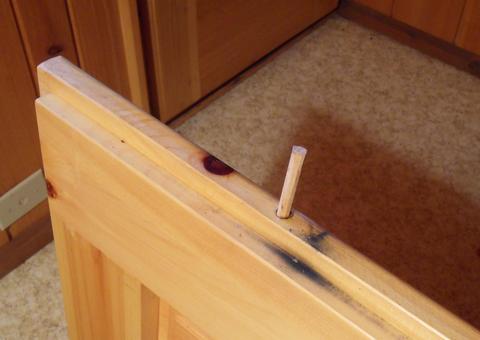 This would mean moving the hinges by only half a centimeter on the door, which in
turn would mean the new mounting holes would have to overlap the old ones.
This would mean moving the hinges by only half a centimeter on the door, which in
turn would mean the new mounting holes would have to overlap the old ones.
I figured this job would be another cool application for my self-centering dowel jig. So on my next visit, I brought along that jig.
I unhooked the door (easy enough without undoing anything with these clever hinges), unscrewed the hinges from the door, and whittled hardwood pegs to fit in the existing hole.
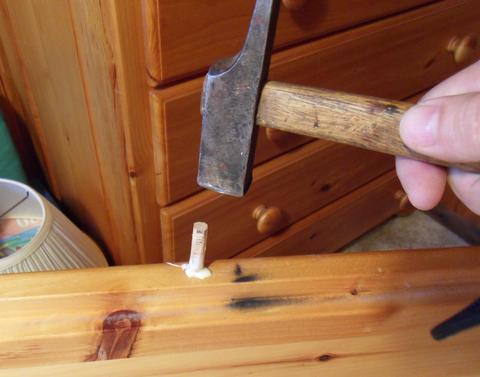 I made sure the pegs fit tightly and glued them into the holes.
I made sure the pegs fit tightly and glued them into the holes.
Once the glue dried, I cut the pegs flush with a hacksaw.
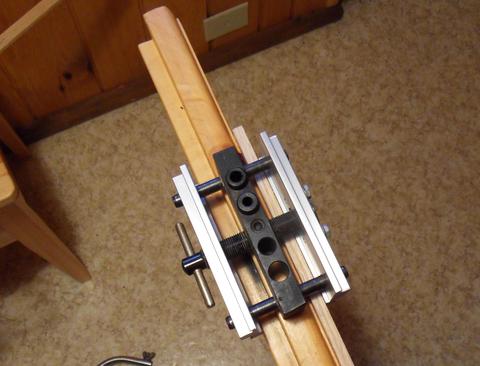 Next came the jig. The jig is self-centering, but the holes actually needed to be off
center. The jig can be miss-assembled to be off center, but it was easier to just use
a piece of wood as a spacer to get the jig in the right place.
I set the jig to drill a hole halfway
overlapping with the old hole that I'd just filled with the peg.
Next came the jig. The jig is self-centering, but the holes actually needed to be off
center. The jig can be miss-assembled to be off center, but it was easier to just use
a piece of wood as a spacer to get the jig in the right place.
I set the jig to drill a hole halfway
overlapping with the old hole that I'd just filled with the peg.
 I used a 1/4" (6 mm) drill in the appropriate sized hole in the jig. The jig guided
the drill firmly enough that I was able to drill overlapping with the existing
hole without having the drill wander.
I used a 1/4" (6 mm) drill in the appropriate sized hole in the jig. The jig guided
the drill firmly enough that I was able to drill overlapping with the existing
hole without having the drill wander.
I actually needed a hole just slightly larger than 1/4", so after drilling the 1/4" hole, I removed the jig and drilled freehand with a larger drill in the hole. The hole I had already drilled was enough to guide the drill straight.
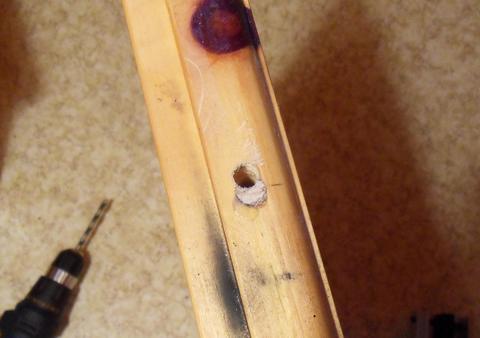 The finished overlapping hole.
The finished overlapping hole.
Now it was just a matter of reinstalling the hinges and mounting the door back in the frame. Fortunately, I'd moved the holes by the right amount. Far enough that the door cleared the top part of the door frame, but not far enough for it to drag on the floor.
More about this : Self-centering dowel jig